-
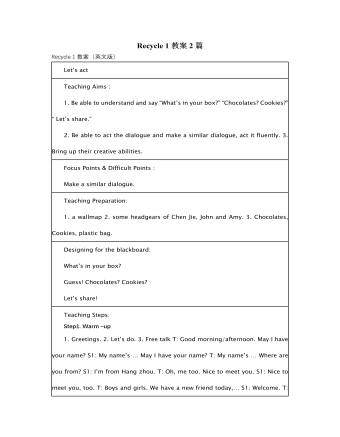
人教版新课标PEP小学英语三年级下册Recycle 1教案2篇
1.猜袋中东西数 将全班分成若干小组,每组抽一人到前面,背对着班级。教师拿一个袋子,并向学生们借一些书本,铅笔,钢笔,橡皮等,放入袋中,然后让各组学生轮流猜袋子里东西的数目,猜对的给该组记10分。 2.学生一起有节奏地说唱Let’s chant部分的歌谣,并请学生分角色表演。 (二)呈现新课 (Presentation) 1.抢读单词 教师将全班分成若干小组,然后逐个出示一些图片,学生们举手抢答,教师让最先举手的学生将图片的单词说出来,说对的给该组记10分,得分最多的组为优胜。 2.看单词卡读出单词并说出中文,复习1-3单元要求四会的单词。 3.教师用实物投影出示1-3单元课文中的某一幅图片,让学生根据图片内容进行对话练习。 4.让学生填写Assessment部分的内容,自己对1-3单元所学内容的掌握情况进行自我评价。 5.教师向学生出示已制作好的window card:This si a window card.并教读window card教师问学生:Do you like it? Can you make it? Do you want to learn how to make a window card?
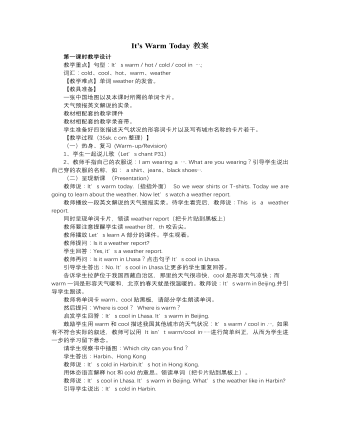
人教版新课标PEP小学英语四年级下册It’s Warm Today教案
1、Read and Write部分的课件及录音。 2、Pronunciation部部分的录音。 3、单词卡片:sunny,warm,cold,snowy,cool,cold, cloudy, hot, rainy, windy。 【教学过程 】 (一)热身、复习 (Warm-up/Revision) 出示单词卡:warm,hot,cool,cold,rainy,snowy,windy,sunny,cloudy,学生集体朗读。 请学生打开书P52,看记录回答教师问题: 教师提问:What’s the weather like in Beijing? What’s the weather like in Shanghai? 请4位学生分别提问Harbin,Lhasa,Urumqi,Hongkong的天气,大家回答。 请学生朗读P51对话后的句子:It’s cool. 在本上认真书写句子It’s cool. 教师要巡视检查。 (二)呈现新课 (Presentation) A. Lead-in 请学生继续看记录,教师提问: Is it warm in Beijing? Is it snowy in Harbin? Is it cool in Shanghai? Is it windy in Lhasa? Is it cold in Urumqi? Is it hot in Hong Kong? 引导学生根据记录用Yes, it is. 或No, it isn’t. 回答。 请学生用Is it…?分别猜一猜London,Sydney,Singapore,Moscow的天气,教师前一天根据天气预报情况用Yes, it is. 或No, it isn’t. 回答学生的提问。 请学生朗读P51对话后的句子:Is it cold?并说出意思。 学生在本上规范书写句子Is it cold?教师提示学生注意标点是?。
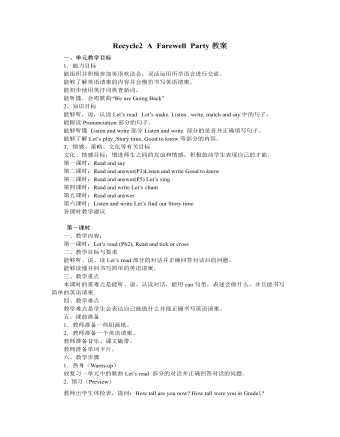
人教版新课标PEP小学英语六年级下册Recycle2 A Farewell Party教案
3. 新课呈现(Presentation) Let’s make (1)教师说:Miss White is making a book about her students. So she can remember them well.Who are the students? 请学生独立或分小组朗读四段短文,解释学生不理解的句子,然后说:There are four pictures below. Would you like to help Miss/White glue the pictures? 教师知道学生完成图文搭配的练习。 (2)教师发给每名学生一张铅画纸,说:Now please draw a picture of your best classmate. Then describe him or her.学生画一副最要好的同学的肖像,并在傍边配上对该同学的英语介绍。 学生上讲台介绍自己最要好的同学,请其他学生猜是谁,看谁说的生动又贴切,教师给予评价时注意强调第三人称单数形式的使用。 Story time 教师向学生展示Story time部分的教学挂图,指着最后一副图中的Zoom 和 Zip说 Look at the picture. Zoom and Zip are sad. They are saying goodbye to each other. Now let’s see What happened. 学生同桌之间合作阅读或是,然后教师提出问题Where is Zip going? Is this good news for zoom ? What grade is Zip going to be in? 教师放录音,学生录音跟读故事,然后再分角色朗读.
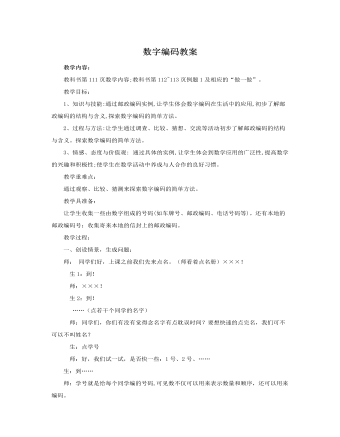
人教版新课标小学数学五年级上册数字编码教案
2、互动交流,探究规律。 (1)、小组内交流讨论: 让每个同学说出自己的发现,说说自己的猜想,并讨论邮政编码中的数字是怎样编排的。(师巡视,随机参与讨论。) (2)、全班展示交流: 师:那个小组愿意先来展示一下你们的探究结果? 生1:我们发现邮政编码都是由6个数字组成的。…… 生2:我们发现前两位数字表示省,如…… 生3:同一个省、市的邮政编码前三位数字相同。比如……。 (让学生充分发言) 【设计意图:“自主探索——互动交流——汇报展示”,充分展现学生自主探究的过程,突出了学生的主体地位,培养了学生自主获取知识的能力和合作交流的意识。】 3、共同优化,形成结论。 (1) 教师配合多媒体课件说明邮政编码的结构和组成: 师:我国邮政编码的结构与含义采用“四级六位制”。编码含义:邮政编码的六位数字分别代表了省、市、邮政、县市、投递局四级单位。其中:前二位表示省(自治区、直辖市);前三位表示邮区;前四位表示县(市);最后两位表示投递局(所)

人教版新目标初中英语八年级上册How do you make a banana milk shake教案2篇
1. First, ... then, ... next, ... finally, ...首先,……然后,……接着,……最后,……这是英语中表达做某事的步骤的一种说法。如果步骤较多,还可以说:first-next-after that-later on-finally/at last通常你会听到说英语国家的人在说 first, next, then, finally 和后面的内容时,他们会做一些停顿。这样就能提前告诉听者接下来讲的是一系列的步骤。这一点在朗读和听力中应特别注意。2. how many, how much均为疑问词,同是“多少”,但用法不同。请看:how many修饰可数名词复数,how much修饰不可数名词。但在用法上,同学们常犯如下错误:1) [误] How many are there bananas on the table?[正] How many bananas are there on the table?[析] how many, how much 中的many,much是形容词,常修饰名词作定语,故后面跟名词。2) [误]How much tea are there on the table?[正]How much tea is there on the table?[析] how much修饰不可数名词时,谓语动词用单数。how many与how much的区别可简记为:前how many:问“多少”,复数名词后面跑;how much问“多少”,不可数名词单数好。前者答语用基数词,后者答语用数量关系。

人教版新目标初中英语八年级上册Can you come to my party教案3篇
Step 3 (3b)First, tell the students when we talk about our future plans, we often use: I’m+verb+ing When we talk about what we must do, we use have to. Ask the students to fill in the blanks in 3b. The answers are: shopping, go to see, a test, I’m going, my family. Step 4 (3c)Let the students write an e-mail message to a friend. Say why you can’t visit next. Before the exercise, ask the students to give some possible answers and write them on the blackboard. So the students will feel easy to finish the writing exercise. After they finish it, Let them to correct it in groups first. Each group chooses theirs best one to read in front of the whole class. Step 5 ( planning a party )First read the conversation in the box together. Then ask the students to turn to page 88.Write down everything you have to do next week. Write in all the things you have to do . Ask the students to look at the list. Ask them “What day are you free?” This is when you can have your party. Step 6 (Self check 1 )Let the students to fill in the blanks with the words given. Change the forms of the words if possible. Then make their own sentences. The answers are: visit, playing, have to, study, comeStep 7 (Self check 2)Imagine you are Marie. Read the information and look at your schedule. Write replies to the invitation.

人教版新目标初中英语八年级上册How was your school trip教案2篇
“Go for it!” is based on “Task-Based Language Teaching”. It adheres to “The authenticity principle”, “The form-function principle”, “The task dependency principle” and “The principle of learning by doing”. These principles all accord with the demands of curriculum focus.In and of Grade Seven (II), “Go for it!”, students have learned “The Simple Past Tense”. And it appears again in of Grade Eight (I). teaches students more about how to talk about events in the past. In addition, it gives affirmative and negative statements in the past tense, such as the sentence patterns “Did you see …?” “Were there …?” “Did you go …?” As the first part of Unit 8, Section A opens with a picture presenting the last school trip in the aquarium and continues with several step-by-step practice activities, which are all good for students to master “The Simple Past Tense”. Doing well in Section A will help students integrate the new target language with that in Section B. Thus, they can describe the events in the past freely and foster their own ability of reflecting and practicing. II. Teaching ObjectivesTeaching objective is the beginning and aim of teaching activities. According to the overall goal of the English elementary course--- improve students' synthetic ability of language application, which should be based on the development of students’ “Language knowledge”, “Language skills”, “Character building”, “Learning strategies” and “Cross-cultural awareness”. The teaching objectives are described as follows(I). Knowledge objectivesi. Master the simple past tense of regular and irregular verbsii. Recite the new words and expressions about the last school trip in the aquarium, including their pronunciation and intonation

人教版新目标初中英语八年级上册How do you get to school教案2篇
Step Ⅶ Role play ( Work on 1b)1. First ask two students to read the dialogue to the class.Sa: How do you get to school?Sb: Well, I ride my bike to the subway station. Then I take the subway.2. Now work with a partner.Suppose you use two kinds of transportation to get to school \Hangzhou\Beijing... (bus, train, subway, walking, bike, etc.) Tell how you get there. You may use the phrases in 1a.3. Then ask different pairs of students to present their conversations to the class.Step ⅧListening1. Work on 2a(1) First ask students to read the list of information that Thomas wants to know.…where Nina lives.…how far from school she lives.…how long it takes to get to school.…how she gets to school.…what she thinks of the transportation.(2) Tell students what transportation and bus stop mean.bus stop 汽车站 transportation n. 运送;运输Then tell students we'll hear a recording. Please put a checkmark in front of each thing that Thomas wants to know.(3) Now play the recording for students.( Have students pay attention to the sample answer.) (4) Then correct the answers.

人教版新目标初中英语八年级上册I’m going to be a basketball player教案3篇
教学目标1.知识目标:(1)学习What are you going to be when you grow up?/How are you going to do that?句式。(2)学会用英语描述有关职业的表达法。2.能力目标:(1)能够谈论为实现理想所做出的打算和安排。(2)能够谈论未来自己与他人理想的职业及原因。(3)能用英语描述课余时间的活动安排,最终具备表达综合信息的能力。3.情感目标:新学期到来之际,让他们在学习、体育、饮食、特长、读书等方面制定计划,教育学生合理安排自己的课外生活,思考自己的理想职业及适合自己的职业。教学重点、难点本单元的重点为“be going to”表将来,want to be, what,where, when,how引导的特殊疑问句。难点是语言目标的实现。教材分析本单元以I am going to be a basketball player为话题,共设计了三部分的内容:一、Section A该部分有4个模块。第一模块围绕Do you think these jobs are interesting?这一话题展开思维(1a)、听力(1b)、口语(1c)训练;

人教版新目标初中英语八年级上册I’m more outgoing than my sister教案2篇
1 交通工具的比较此活动为小组活动。学生通过讨论找出到达某一城市可乘坐的各种交通工具,并选择最佳出行方式。Teacher:We’re going to Shanghai. How many ways can we use to get there? Yes, there are four ways: by bus, by plane, by train, by ship. Please discuss how you are going to get there.操作建议:(1)学生以小组为单位展开活动,谈论本组所选择的交通工具。(2)各组选代表向全班汇报,阐述本组所选择的交通工具的利和弊。完成任务所需要的语言结构:We can go there by ship. It’s more comfortable and cheaper than any other transportation.We can go there by bus. It’s cheaper but it takes longer time.2 哪个城市更合适?此活动具有挑战性。假设中国要举行2014年世界杯足球赛,分别从历史,人文,天气等方面对各城市(北京,大连,上海,昆明)进行比较,选择最佳举办城市。T: Imagine China is holding the 2014 FIFA World Cup. Which city do you think is the best for the World Cup, Beijing, Dalian, Shanghai or Kunming? Let’s work in groups. If you choose Beijing, please join the Team Red. If you chose Dalian, please join the Team White. If you choose Shanghai, please join the Team Blue. If you choose Kunming, please join the Team Green. Please show us its advantages. Then let’s see which team will win.

人教版新目标初中英语八年级上册What’s the best radio station教案2篇
教学重点和难点:运用所掌握的语言描述,比较不同地点的特点。在练习中学习掌握英语比较级和最高级的用法。课前准备分配小组,每组五至六人。通过上网或翻阅报刊杂志等方法,确定旅游线路,做出基本的旅游计划。教学设计:本节课流程图 学法指导:1.由于这是一堂新课,在教学中应注意面向全体,发挥学生的主体性,引导学生积极参与,激发学生的求知欲和学习积极性,指导学生积极思维,主动获取知识,养成良好的学习方法。逐步学会独立解决问题。总之要尽可能调动学生的非智力因素促进智力因素的发展。教法选择:1.电化教学法2.课堂讨论法3.任务型教学法采用这些方法的目的是为了充分调动学生的学习积极性,使学生变被动学习为主动学习。通过电脑形象的演示,加强印象,提高兴趣,突破难点,提高教学效率,进而增大教学的容量和信息量。充分体现教师为主导,学生为主体的教学原则。

人教版新目标初中英语八年级上册What’s the matter教案2篇
She shouldn’t go to the party tonight.Step7. TaskT: You know, there are lots of problems in our life. If you are a doctor, please tell us how to solve the problem. I will divide you into 9 groups. Please work in groups. And then choose one of you to report your ideas.The following are the problems:I have a toothache.I am hungry. I have a sore throat.I am stressed out. I have a sore back.I am tired. I can’t sleep.I have a cold. I have a headache.Report: If you have a headache, you should go to bed early. You should see the doctor. You should eat some medicine. You shouldn’t wash your face with cold water.You shouldn’t sleep late.You shouldn’t swim.…..T encourages the students to give advice as much as possible.Homework:1. Chose one of the problems, and write down your advice2. Copy the new words这一步是用于热身的,同时也可以让他们复习一部分的表示人体部位的单词,扩充知识.学习语言的过程也是一个不断积累的过程,复习旧知识,增添新知识.通过小游戏,强化学生对Does she/he have…这个句子的运用能力.通过复习,自然的引到下面新知识的学习。充分利用表格,由句子到对话,再到文章,让学生循序渐进. 提高学生的综合语言运用能力,运用以前学过的知识来解决身边的问题.Period 5 (Section B 3a—3c, selfcheck)教学内容与分析:

人教版新目标初中英语八年级上册Could you please clean your room教案3篇
一、 教学内容Section A 1a----1c二、 教学目标1.学习词汇do the dishes, make the bed, take out the trash, fold the clothes, do the laundry, sweep the floor, clean the living room.2.句型 Could you please clean your room? Yes, sure.三、 教学准备 学生预习本单元所有的词汇多媒体课件 活动表 奖品四、 教学过程Pre-task1. Warming upEnjoy ourselves. Watch cartoon Cinderella. 看动画片段《灰姑娘》导如入本课话题和新词汇“chores”美丽善良的鬼姑娘因继母的嫉妒,每天得做所有的家务。片段的主题使学生联想到本课的话题。2. learn new words and phrasesLook! What is she / he dong? 看图学习动词词组do chores, do the dishes, make the bed, take out the trash, fold the clothes, do the laundry, clean the living room.3. Guessing game.What is she doing ? 4. Pair work. 1a, Do you do these things at home? Write “Y” for “yes” and “N” for “no”.5. Listening . 1b , Peter’s chores or Mom’s chores?理解目标语Could you please clean your room? Yes, sure.Write “M” for Mom’s chores, “P” for Peter’s chores in the chart.6. PairworkLook at the picture,Ask your partner to do the chores that you see. 7. Interview Who is the most able at home? 1) What chores do you do at home? How often do you do the chores? Work in four, interview each of the students in the group, fill in the chart.

人教版新目标初中英语八年级上册What are you doing for vacation教案2篇
Teaching goals : 1. Words & phrases: babysit ,get back , fishing , rent , think about , decide(on) , tourist etc. 2. How to talk about future plans . 3. 现在进行时表示将来计划或行动. 4. 特殊疑问句(where , when , how long引导) Important and difficult points : Drills :What are you doing for vacation ? I’m watching TV . When are you going ? I’m going … . How long are you staying ? We’re staying for five days . Teaching aids : cards and a tape ,a large wall calendar . Period 1 Teaching procedures : Step 1Leading in1. Free talk . 2. Put up the wall calendar . T: I’m staying home on Saturday (pointing to next Saturday ).Ss repeat . Ss: I’m staying home on Saturday . T: OK. Today we’ll learn how to talk about future plans. Step 2Pre-task SB Page 13 , 1a . 1. Look at the picture carefully and tell what you see in the picture . 2. Write the activities from the pictures in the box and add some more . 3. Practice reading . Step 3While-task1. Using the activities we write in 1a to make conversations .For example :What are you doing for vacation ? I’m visiting my uncle . 2. Pairwork .Practice in pairs . 3. 用第三人称练习对话.
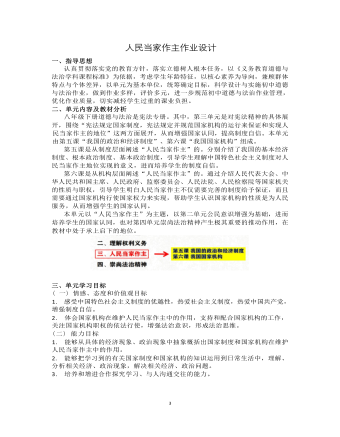
道德与法治八年级下册人民当家作主作业设计
①坚持依法行政,维护公平正义②严格遵循诉讼程序,加强立法③司法过程和结果都要合法、公正④坚持以事实为根据,以法律为准绳A.②④ B.②③ C.③④ D.①②3.疫情防控期间,某地检察院充分发挥检察职能,与公安机关等部门加强协作, 提前介入涉疫案件侦查,切实保障人民群众合法权益,全力维护疫情期间社会稳 定。由此可见 ( )①人民检察院是我国的法律监督机关②公安机关是我国的审判机关③公平正义需要法治的保障④人民检察院接受政府的领导和约束A.①② B.①③ C.②③ D.②④(二) 非选择题4. 探究与分享:结合所学知识,与同学讨论探究,回答下列问题。案例反思:2017 年 4 月 20 日,最高人民法院、中央电视台联合公布 2016 年推动法治进程十大案件评选结果,聂某被宣判无罪案等十大案件入选。1995 年 3 月,石家庄中院一审判处聂某死刑,同时判处赔偿受害人家属丧葬费等计 2000 元。1995 年 4 月 27 日,聂某被执行死刑。2016 年 12 月 2 日,最高人民法 院第二巡回法庭宣告撤销原审判决,改判聂某无罪。2017 年 3 月,聂某家属获 268.13991 万元国家赔偿。思考:如何才能避免这种错案的发生?

道德与法治八年级下册理解权利义务3作业设计
2.内容内在逻辑本单元为八年级下册第二单元内容。本单元由导语、第三课和第四课组成、第三课“公民权利”设有两课,分别是“公民基本权利”和“依法行使权利”、第四课“公民义务”设有两框,分别是“公民基本义务”和“依法履行义务”。单元导语首先明确中学生在国家中具有公民身份,是国家的主人,依法享受公民权利并承担公民义务。指明公民基本权利和义务是宪法的核心内容,从而激发学生学习公民基本权利和义务具体内容的兴趣。引导学生进一步探究如何依法行使公民权利、如何依法履行公民义务,思考依法行使公民权利、履行义务对个人、家庭、社会及国家的重要意义。引言指明了公民权利对于我们参与社会生活、实现人生幸福的意义,意在引发学生对公民权利在个人成长、社会进步与国家发展方面所具有的价值的初步思考,启发学生思考如何依法行使和维护自身享有的公民权利,进而导入新课。
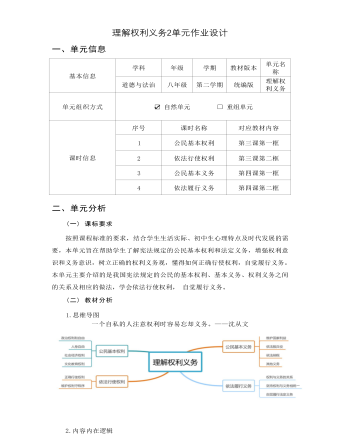
道德与法治八年级下册理解权利义务2作业设计
本单元在整册教材中起到了承前启后的作用:第一单元《坚持宪法至上》主 要是培养学生的宪法意识,为后面的内容打下思想基础,通过本单元的学习,让 学生进一步认识宪法规定的公民基本权利和基本义务,帮助学生树立正确的权利 观和义务观,是对第一单元内容的深入和延伸;第三单元《人民当家做主》主要 是帮助学生更多的了解我国基本制度和国家机关,鼓励学生积极参与政治生活, 增强对国家的认同感和主人翁意识,学生需要学会正确行使公民的政治权利和自 由,因此,本单元又为第三单元内容的学习打下基础,作好铺垫。其中,第三课主要介绍公民的基本权利、如何正确行使权利及公民维权的途径,帮助学生树立正确的权利观;第四课主要介绍公民的基本义务、如何自觉履 行义务及违反义务须承担的责任,并在两课的基础上总结权利和义务的关系,帮 助学生树立正确的义务观,最终形成“权责一致”的观念。
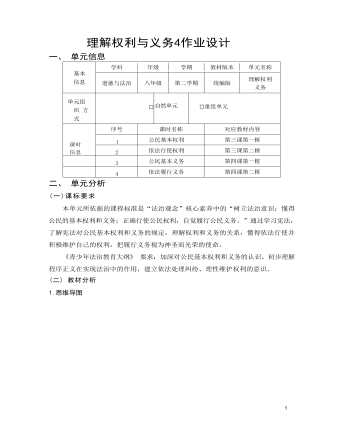
道德与法治八年级下册理解权利义务4作业设计
某小区突发火情。消防中队接警后迅速赶来, 但由于沿途不少车辆乱停放堵 住道路, 消防车无法顺利进入小区。危急时刻, 小区一名热心大姐奋力呼救, 号 召周围居民配合物业人员一起用人力将沿途车辆一一搬开, 这才让消防车顺利抵 达起火楼栋,经过及时疏散,无人员伤亡。某校八(2)班以上述新闻为背景,组织一次以“依法行使权利,让生命通 道畅通”为主题的社会实践活动。请你参与其中。 (1)调查组的同学在某小区发现有一辆私家车占用了消防通道。联系车主后, 该车主说: “我自己的车, 想停哪儿就停哪儿, 哪有那么多火灾! ”请你从“权 利与义务的关系”的角度对其进行劝说该如何处理好权利和义务的关系。①公民的权利与义务相互依存、相互促进。 ②公民既是法定权利的享有者, 又是法定义务的承担者。 ③我们不仅要增强权利意识, 依法行使权利, 而且要增 强义务观念, 自觉履行法定的义务。因此, 作为小区居民, 我们在依法行使停车 权利的同时也要自觉履行维护小区消防安全的义务。
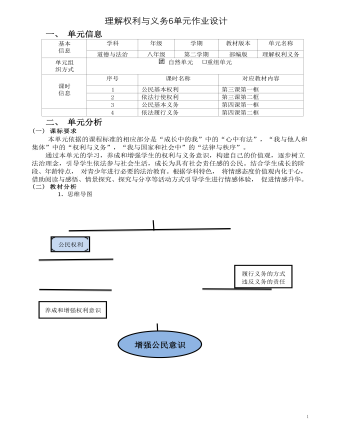
道德与法治八年级下册理解权利义务6作业设计
1.【解析】根据教材所学,依法治国要求全民守法,正确行使权利,自觉履行义务, A项没有履行依法纳税的义务,排除; B项没有履行服兵役的义务,排除;C项侵害救火英雄的名誉权,是一种违法行为,要承担相应的法律责任,故排除;D项自觉履行了维护国家安全和利益的义务,故符合题意。【答案】D2.【解析】该题考查公民的权利和义务的关系; 依据课本内容,公民的权利和义务是一致的。公民的权利和义务是密不可分的, 没有无义务的权利,也没有无权利的义务;题干中“不愿履行或轻视义务”割裂了权利与义务的关系,没有树立起正确的权利义务观念。 所以A项正确; BCD错误。【答案】A。3. 【解析】本题主要考查遵守宪法和法律这一公民基本义务。遵守和维护社会秩序是这一基本义务的具体要求,不服从国家疫情封控管理属于扰乱社会秩序的违法行为, 要承担一定的【答案】(1) 劝阻爸爸。(2) 自觉维护社会秩序, 依法履行公民义务, 法律要求的必须做,禁止做的坚决不做,否则就会受到法律制裁。

道德与法治八年级下册理解权利义务7作业设计
②积极参与国家事务和社会事务的管理③在享有劳动权利的同时,也履行了劳动的义务④既获得了劳动报酬,也为国家和社会作出了贡献 A.①② B.②③ C.①④ D.③④11.2020 年 6 月 19 日,国家林业和草原局、农业农村部发布通知,就《国家重点 保护野生动物名录》公开征求意见。画眉、啄木鸟、田螺等被增列入名录中,55 个鲸豚类和猛禽类等物种保护等级升级。作为中学生,保护野生动物是:( ) A.法律禁止做的,我们坚决不做 B.法律要求做的,我们必须去做C.道德要求做的,我们积极去做 D. 自觉自愿行为,可做也可不做 12.遇到交通肇事,不按照正常程序处理,而是采取极端的方式解决。陕西省榆 林市公安局榆阳分局镇川派出所,对涉嫌非法入侵他人住宅的 5 名嫌疑人刑拘。 这表明:( )①公民的住宅不受侵犯②禁止非法搜查或者非法侵入公民的住宅③公民权利如果受到损害,要懂得依照法定程序维护权利④我们在行使自由和权利的时候,不得损害其他公民的合法的自由和权利





